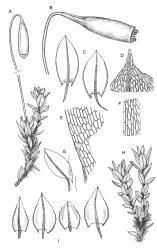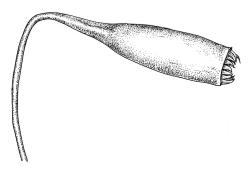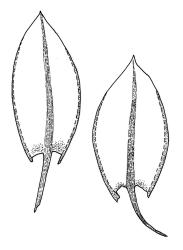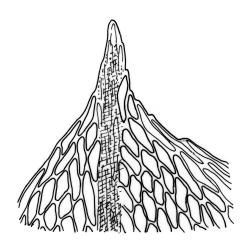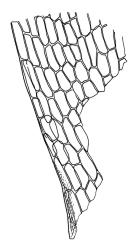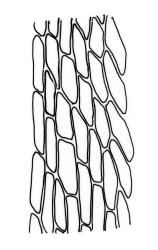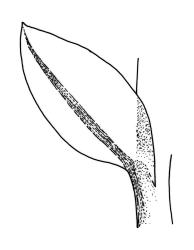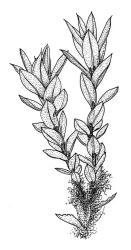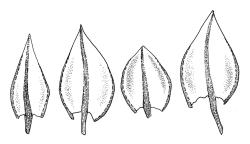- ≡ Mnium pseudotriquetrum Hedw., Sp. Musc. Frond. 190 (1801)
- ≡ Ptychostomum pseudotriquetrum (Hedw.) J.R.Spence & H.P.Ramsay in Spence, Phytologia 87: 23 (2005)
- = Bryum maudii R.Br.bis, Trans. & Proc. New Zealand Inst. 31: 460 (1899)
- = Bryum obesothecium R.Br.bis, Trans. & Proc. New Zealand Inst. 31: 459 (1899)
Plants bright or dark-green, usually strongly tinged with red, robust or medium-sized. Stems dark red to nearly black in lower portions, to at least 55 mm, often forked, beset below with coarsely papillose, red-brown rhizoids, in cross-section with several layers of firm-walled cortical cells and a strong central strand. Leaves evenly spaced on stem, erect-spreading or wide-spreading when moist, much altered and incurved or ± twisted around stem when dry, broadly ovate-lanceolate to broadly elliptic, narrowed at insertion, acute and ± cuspidate at apex, variable in size, mostly 1.5–2.7(–3.0) mm (excluding perichaetial) on well-developed stems and with lamina ± 100% of the total leaf length, weakly concave to nearly plane, red below, entire or denticulate near apex, bordered, recurved at margins in lower two-thirds or nearly to apex, narrowly but distinctly decurrent (and often with a "tail" remaining attached to the costa when removed); upper laminal cells oblong-hexagonal, firm-walled, not or weakly porose, (30–)36–54 µm long (rarely shorter in compact forms) and mostly 2.5–4:1, shorter at apex, and larger and ± oblong in lower leaf; marginal cells linear and forming a distinct border (mostly c. 5 cells wide at mid leaf) extending to apex; basal cells strongly pigmented but not otherwise differentiated. Costa stout, red at base or throughout, shortly excurrent or percurrent. Brood bodies (including tubers) absent.
Synoicous in N.Z. material. Perichaetia terminal or appearing lateral due to overtopping innovation; perichaetial leaves larger (to c. 3 mm) than vegetation but not otherwise differentiated. Setae very long, to c. 50 mm, red below, pale brown above, cygneous just below capsule; capsules pendent, oblong-cylindric, 3.5–4.5 mm, with a well-defined neck ⅓–½ its total length; operculum mammillate, apiculate. Exostome teeth yellow-brown, finely papillose below, baculate near apex; endostome segments fenestrate; cilia (2–)3, well-developed and appendiculate. Spores 15–18 µm.
Crum & Anderson 1981, figs 258, 259 A–G; Seppelt 2004, fig. 42; Spence & Ramsay 2006, fig. 44 S–Y (as Ptychostomum pseudotriquetrum); Ochyra et al. 2008, figs 218, 219.
A robust habit, spreading, non-comose, distinctly decurrent, entire and bordered leaves with weakly excurrent or percurrent, red costae characterise this species of wet soils. The synoicous inflorescence is a particularly useful feature. In sterile material the leaves are widely spaced, which makes the decurrent leaf base obvious; in fertile material the leaves are usually more crowded. The most common form in N.Z. has vegetative leaves >2 mm; however, compact forms occur in which the leaves do not exceed c. 1.3 mm, particularly on the South I. (e.g., A.J. Fife 9177 from Culliford Hill, Nelson L.D., CHR 476994). In some populations the leaves of innovative branches are much smaller (even <1 mm) than leaves occurring on the lower stems (e.g., B.H. Macmillan 75/13 from Mt Olympus, Canterbury L.D., CHR 162832). Generally, there is a strong decrease in leaf size at higher elevations. An unusual form with broadly elliptic, widely obtuse leaves has been collected from wet soil over magnesite at the margin of a cascade in southern beech forest in the Cobb Valley, Nelson L.D. (A.J. Fife 8665, CHR 460781).
Confusion often occurs with B. laevigatum. That species, which more often grows in dry habitats, has a generally coarser appearance, and costae that have little red pigmentation. When dry the leaves of B. laevigatum usually have abaxially strongly protruding costae; when moist its strongly concave leaves contrast with the nearly flat leaves of B. pseudotriquetrum. The upper laminal cells of B. laevigatum are shorter (c. 2:1) than those of B. pseudotriquetrum (mostly 2.5–4:1).
The features that distinguish B. pseudotriquetrum from B. caespiticium are detailed under the latter species.
NI: N Auckland (Tokerau Beach), S Auckland (Ātiamuri, Tāhunaatara Stream), Wellington (Ohakune); SI: Nelson (Mt Mytton, Culliford Hill); Marlborough (Rai River), Canterbury, Westland (Kelly Range, Grey Valley, Lake Matheson), Otago, Southland (Eyre Range). Reported from A by Vitt (1979) and from M by Seppelt (2004).
Bipolar. Reported from Tasmania and mainland Australia by Spence & Ramsay (2006); also recorded by them from Europe, Asia, North America, South America, West Africa, and Antarctica. Ochyra et al. (2008) recorded the Antarctica distribution in detail.
Occurring on damp or waterlogged soil, usually in nutrient rich situations and most commonly in swamps (e.g., raupo swamps, lake margins) or fens, or at stream margins in areas of limestone. Occurring less frequently in crevices of alpine limestone/marble outcrops or on rocks in cascading forest streams (as at Arthur’s Pass) or in alpine grasslands. Commonly associated moss species include Breutelia pendula, Campylium stellatum, Drepanocladus aduncus, and Fissidens adianthoides. From near sea level to c. 2000 m.
In Europe, synoicous material of B. pseudotriquetrum is often segregated as the var. bimum (Schreb.) Lilj. (or at the species level B. bimum (Schreb.) Turner) All the examined N.Z. material is synoicous (including the types of the synonymous R. Brown names) and hence could be referred to that variety. Ochi (1970, 1984) does not recognize this variety, noting instead that at least some N.Z. material is referable to "the so-called 'bimum' form". Crum & Anderson (1981, p. 558), dealing with synoicous material from eastern North America, also concluded that the variety was not worthy of recognition. Under the influence of these authors, a broad view of B. pseudotriquetrum is taken here. Curiously Spence & Ramsay (2006, p. 328) described this species as "dioicous in Australia". The discussion of Spence & Ramsay (2013) does little to clarify the status of B. pseudotriquetrum or its dubious segregates in Australia.
Pohlia elatior Sainsbury, placed incorrectly in the synonymy of B. pseudotriquetrum by Fife (1995), is a sterile, elongate form of P. nutans.




